Facilely Promoting the Concentration of Baicalin in Polylactic Acid Fiber for UV Shielding and Antibacterial Functions: A Customized and Sustainable Approach
Abstract
:1. Introduction
2. Materials and Methods
2.1. Materials
2.2. Properties of Baicalin in Aqueous Solution
2.3. Fabric Treatment
2.4. CCD Experiment
2.5. Measurement
2.5.1. UV–Visible Spectroscopy and FTIR
2.5.2. UV-Protective and Antibacterial Performance
3. Results
3.1. Spectroscopy Analysis
3.1.1. UV–Vis Adsorption Spectroscopy
3.1.2. FTIR
3.2. Methyl-Cinnamate-Assisted Finishing
3.3. CCD Experiment
3.4. Functionality
4. Conclusions
Author Contributions
Funding
Institutional Review Board Statement
Informed Consent Statement
Data Availability Statement
Conflicts of Interest
References
- Swetha, T.A.; Bora, A.; Mohanrasu, K.; Balaji, P.; Raja, R.; Ponnuchamy, K.; Muthusamy, G.; Arun, A. A comprehensive review on polylactic acid (PLA)—Synthesis, processing and application in food packaging. Int. J. Biol. Macromol. 2023, 234, 123715. [Google Scholar] [CrossRef] [PubMed]
- Hussain, T.; Tausif, M.; Ashraf, M. A review of progress in the dyeing of eco-friendly aliphatic polyester-based polylactic acid fabrics. J. Clean. Prod. 2015, 108, 476–483. [Google Scholar] [CrossRef]
- Rojas, A.; Torres, A.; López de Dicastillo, C.; Velásquez, E.; Villegas, C.; Faba, S.; Rivera, P.; Guarda, A.; Romero, J.; Galotto, M. Foaming with scCO2 and Impregnation with Cinnamaldehyde of PLA Nanocomposites for Food Packaging. Processes 2022, 10, 376. [Google Scholar] [CrossRef]
- Saadati Ardestani, N.; Rojas, A.; Esfandiari, N.; Galotto, M.J.; Babhadiashar, A.; Sajadian, S.A. Supercritical Fluid Extraction from Zataria multiflora Boiss and Impregnation of Bioactive Compounds in PLA for the Development of Materials with Antibacterial Properties. Processes 2022, 10, 1787. [Google Scholar] [CrossRef]
- Nagy, B.; Török, F.; Tomasek, S.; Miskolczi, N. Vegetable oil based additives to enhance the properties of PLA/Starch composites: The effect of reaction parameters. Ind. Crops Prod. 2023, 191, 116025. [Google Scholar] [CrossRef]
- Yang, H.; Hu, B.; Chang, F.; Chen, L.; Cao, X.; He, G. Improved compatibility of PLA/Starch blends with Binary functional monomers through UV-induced reactive extrusion. Ind. Crops Prod. 2023, 197, 116635. [Google Scholar] [CrossRef]
- Lukic, I.; Vulic, J.; Ivanovic, J. Antioxidant activity of PLA/PCL films loaded with thymol and/or carvacrol using scCO2 for active food packaging. Food Packag. Shelf Life 2020, 26, 100578. [Google Scholar] [CrossRef]
- Zhou, Y.; Wang, X.; Li, Y.; Wang, W.; Gilchrist, M.D.; Zhang, N. Toward the Scalable Fabrication of Fully Bio-Based Antimicrobial and UVB-Blocking Transparent Polylactic Acid Films That Incorporate Natural Coatings and Nanopatterns. ACS Appl. Mater. Interfaces 2022, 14, 54338–54348. [Google Scholar] [CrossRef]
- Li, Q.; Zhang, N.; Ni, L.; Wei, Z.; Quan, H.; Zhou, Y. One-pot high efficiency low temperature ultrasonic-assisted strategy for fully bio-based coloristic, anti-pilling, antistatic, bioactive and reinforced cashmere using grape seed proanthocyanidins. J. Clean. Prod. 2021, 315, 128148. [Google Scholar] [CrossRef]
- Zhou, Y.; Yang, Z.Y.; Tang, R.C. Bioactive and UV protective silk materials containing baicalin—The multifunctional plant extract from Scutellaria baicalensis Georgi. Mater. Sci. Eng. C Mater. Biol. Appl. 2016, 67, 336–344. [Google Scholar] [CrossRef]
- Zhou, Y.; Zhang, W. Nucleophilic modification of flavonoids for enhanced solubility and photostability towards uniform colouration, bio-activation and ultraviolet-proof finishing of silk fabric. Arab. J. Chem. 2022, 15, 104343. [Google Scholar] [CrossRef]
- Wu, J.; Guo, H.; Ke, J.; Fan, J. Studies on kinetic and thermodynamic parameters of natural dye curcumin on PLA fibre. Indian J. Fibre Text. Res. 2013, 38, 424–426. [Google Scholar]
- Karst, D.; Yang, Y. Using the solubility parameter to explain disperse dye sorption on polylactide. J. Appl. Polym. Sci. 2005, 96, 416–422. [Google Scholar] [CrossRef]
- Wang, L.; Zhao, H.F.; Lin, J.X. Studies on the ultrasonic-assisted dyeing of poly(trimethylene terephthalate) fabric. Color. Technol. 2010, 126, 243–248. [Google Scholar] [CrossRef]
- Ruwizhi, N.; Aderibigbe, B.A. Cinnamic acid derivatives and their biological efficacy. Int. J. Mol. Sci. 2020, 21, 5712. [Google Scholar] [CrossRef]
- Bhatia, S.P.; Wellington, G.A.; Cocchiara, J.; Lalko, J.; Letizia, C.S.; Api, A.M. Fragrance material review on methyl cinnamate. Food Chem. Toxicol. 2007, 45, 113–119. [Google Scholar] [CrossRef]
- Fujiwara, G.M.; Annies, V.; de Oliveira, C.F.; Lara, R.A.; Gabriel, M.M.; Betim, F.C.; Nadal, J.M.; Farago, P.V.; Dias, J.F.; Miguel, O.G.; et al. Evaluation of larvicidal activity and ecotoxicity of linalool, methyl cinnamate and methyl cinnamate/linalool in combination against Aedes aegypti. Ecotoxicol. Environ. Saf. 2017, 139, 238–244. [Google Scholar] [CrossRef]
- Yamazaki, K.; Miyazaki, Y.; Harabuchi, Y.; Taketsugu, T.; Maeda, S.; Inokuchi, Y.; Kinoshita, S.N.; Sumida, M.; Onitsuka, Y.; Kohguchi, H.; et al. Multistep intersystem crossing pathways in cinnamate-based UV-B sunscreens. J. Phys. Chem. Lett. 2016, 7, 4001–4007. [Google Scholar] [CrossRef]
- Kanellis, V.G.; Kanellis, A.L. Availability of Hats That Meet Australian Sun-safety Standards at a Major Canberra Shopping Complex. Photochem. Photobiol. 2020, 96, 945–948. [Google Scholar] [CrossRef]
- GB/T 20944.3-2008; Valuation of Antibacterial Properties of Textiles. Standardization Administration of the People’s Republic of China: Beijing, China, 2008; pp. 1–9. (In Chinese)
- Zhou, Y.; Tang, R.-C. Modification of curcumin with a reactive UV absorber and its dyeing and functional properties for silk. Dye. Pigment. 2016, 134, 203–211. [Google Scholar] [CrossRef]
- Splechtna, R.; Elshehaly, M.; Gracanin, D.; Ɖuras, M.; Bühler, K.; Matković, K. Interactive interaction plot. Vis. Comput. 2015, 31, 1055–1065. [Google Scholar] [CrossRef]
- Krokidi, K.M.; Turner, M.A.P.; Pearcy, P.A.J.; Stavros, V.G. A systematic approach to methyl cinnamate photodynamics. Mol. Phys. 2020, 119, e1811910. [Google Scholar] [CrossRef]
- Zhou, Y.; Tang, R.-C. Natural flavonoid-functionalized silk fiber presenting antibacterial, antioxidant, and UV protection performance. ACS Sustain. Chem. Eng. 2017, 5, 10518–10526. [Google Scholar] [CrossRef]

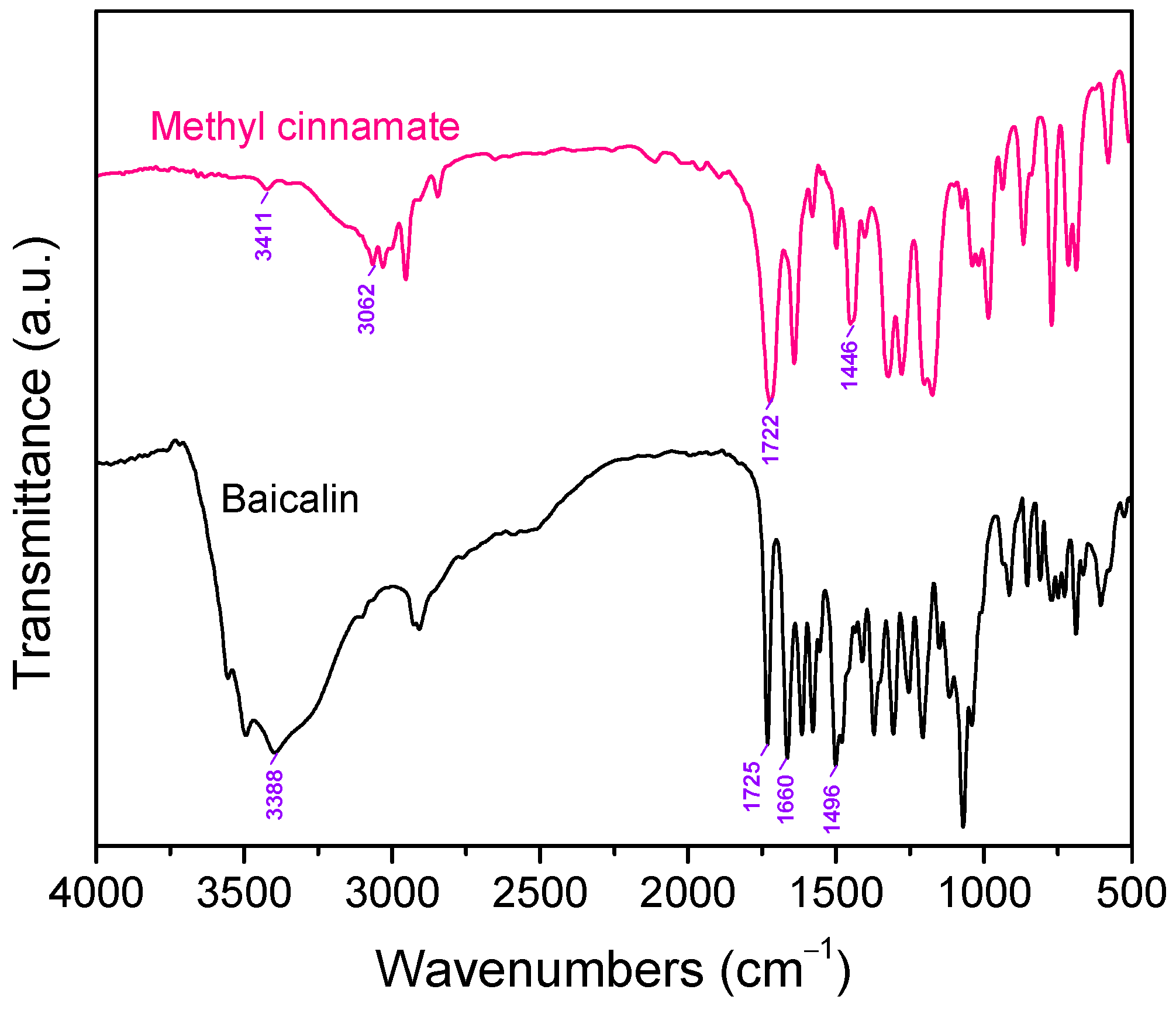

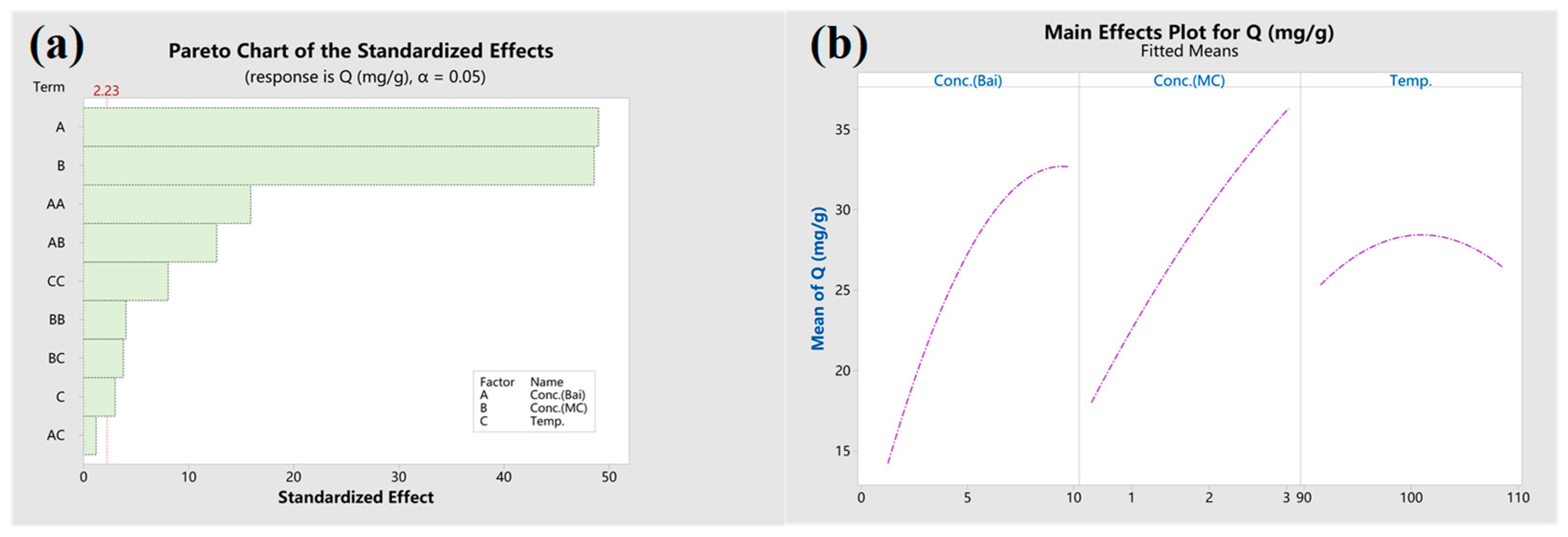

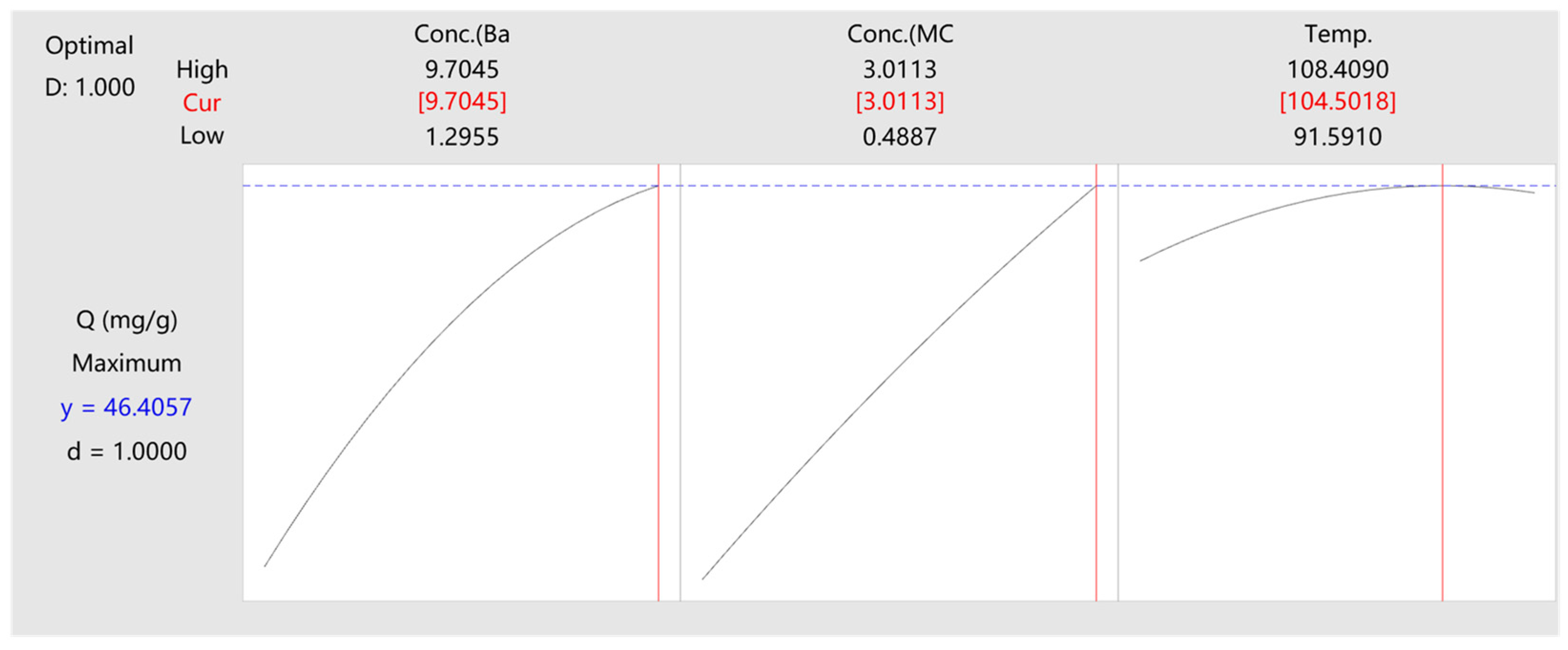
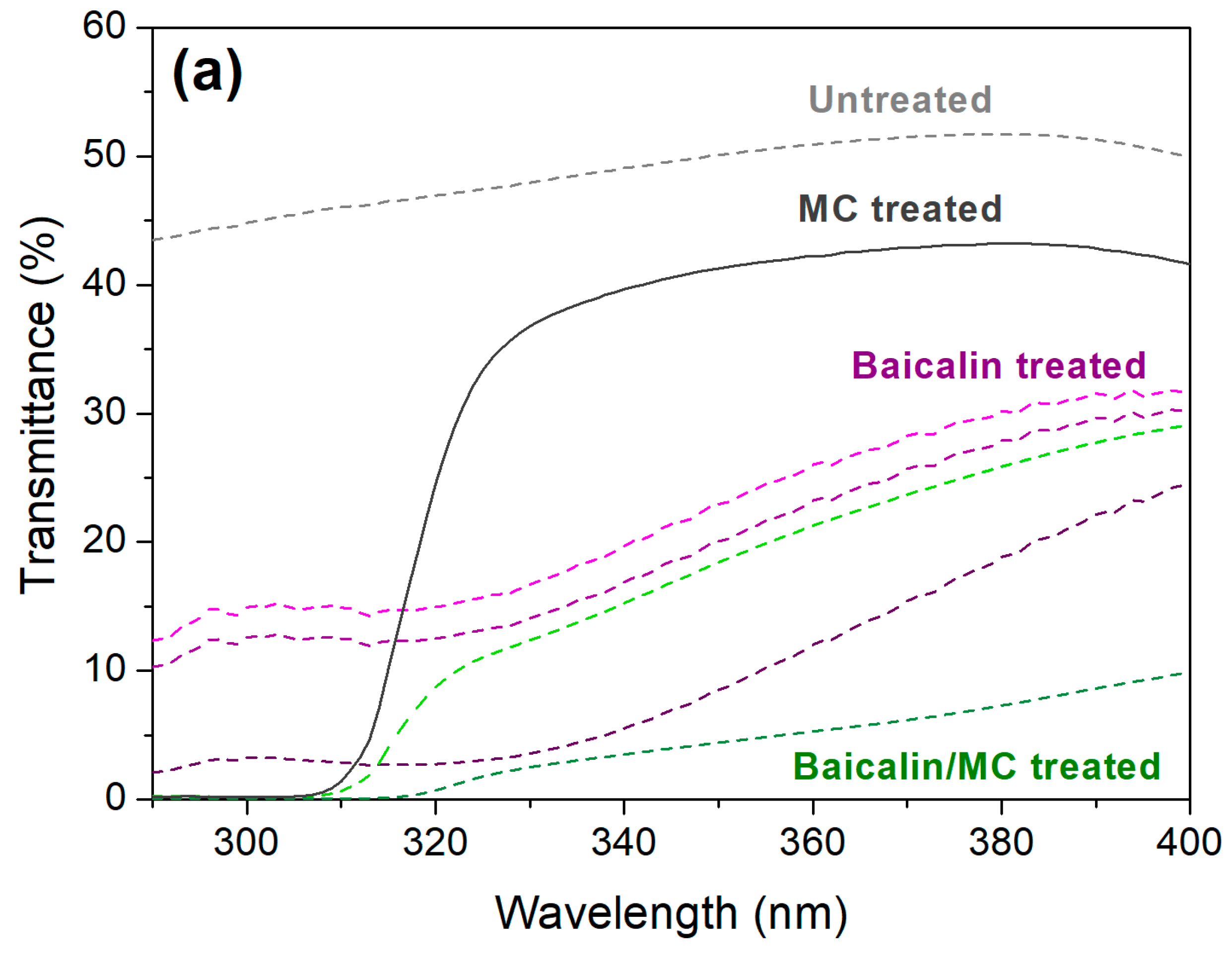
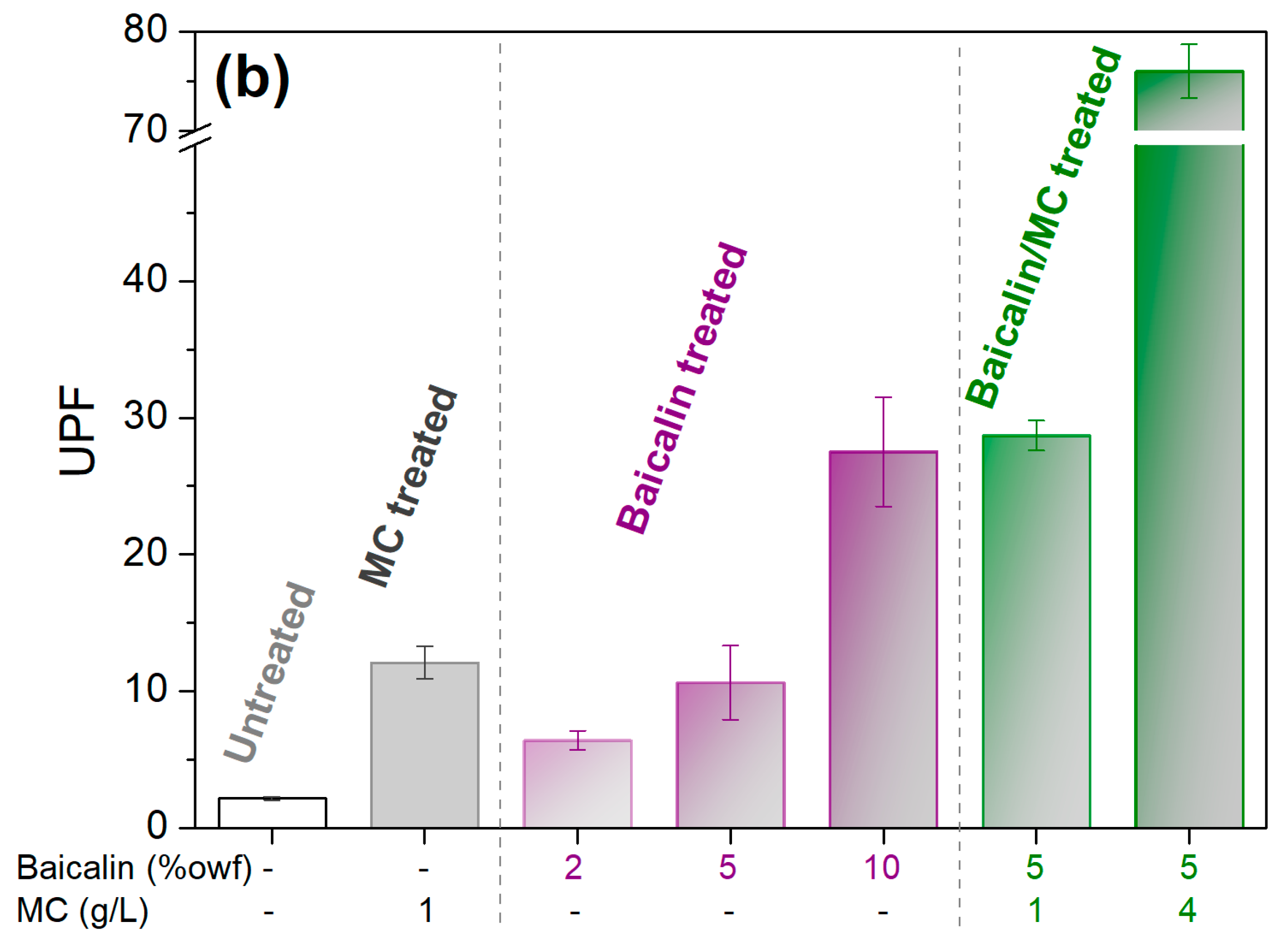
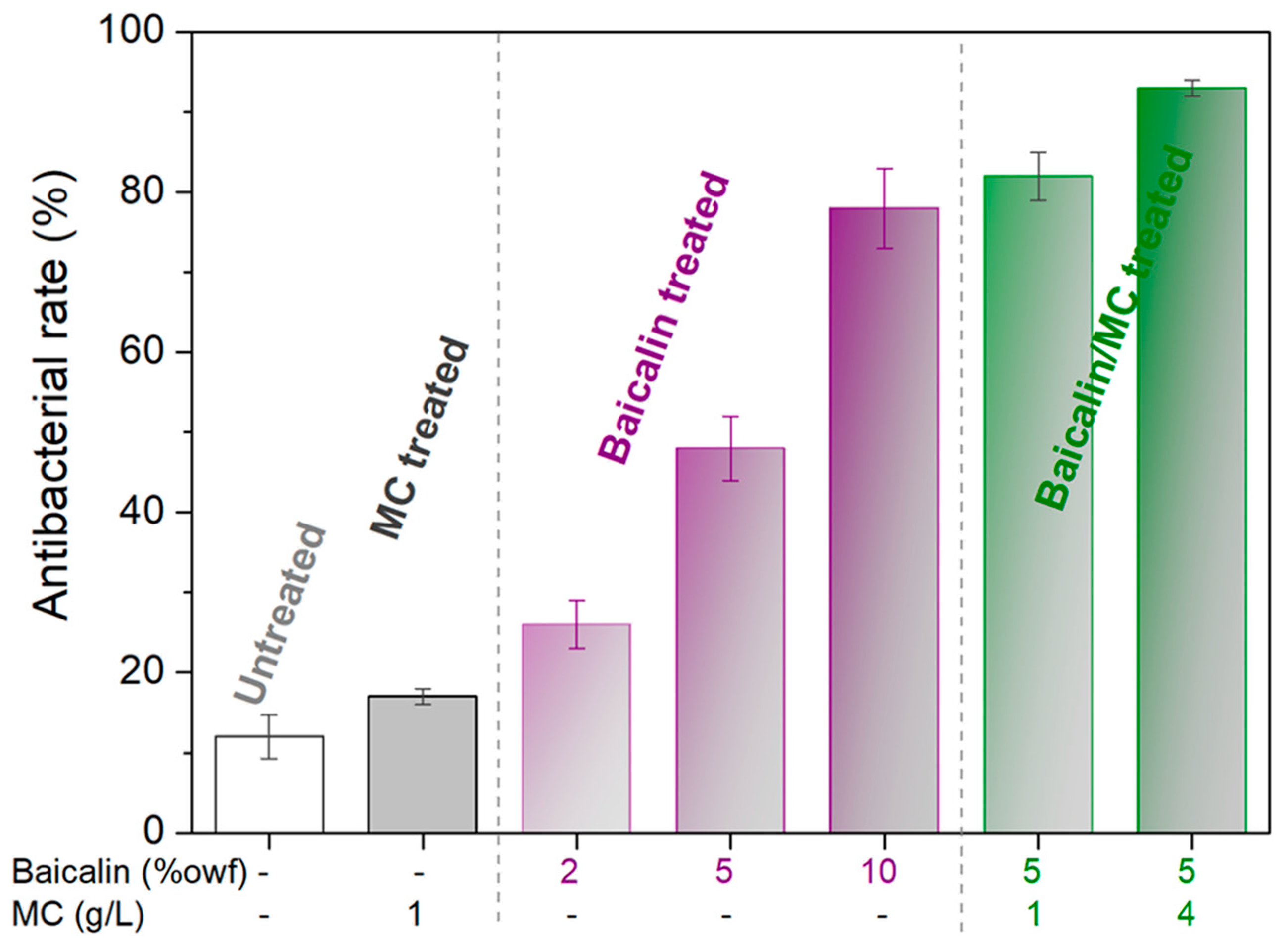
| Variables | Levels | ||||
|---|---|---|---|---|---|
| −α | −1 | 0 | 1 | α | |
| A: Conc.(Bai) (% owf) | 1.3 | 3 | 5.5 | 8 | 9.7 |
| B: Conc.(MC) (g/L) | 0.49 | 1 | 1.75 | 2.5 | 3.01 |
| C: Temp. (°C) | 91.6 | 95 | 100 | 105 | 108.4 |
| Run | Conc.(Bai) (% owf) | Conc.(MC) (g/L) | Temp. (°C) | Quantity (mg/g) | |
|---|---|---|---|---|---|
| Predicted | Actual | ||||
| 1 | 3 | 1 | 95 | 16.79 | 16.68 |
| 2 | 8 | 1 | 95 | 23.63 | 23.21 |
| 3 | 3 | 2.5 | 95 | 22.79 | 22.48 |
| 4 | 8 | 2.5 | 95 | 36.98 | 36.64 |
| 5 | 3 | 1 | 105 | 16.01 | 15.90 |
| 6 | 8 | 1 | 105 | 23.55 | 23.41 |
| 7 | 3 | 2.5 | 105 | 24.21 | 24.17 |
| 8 | 8 | 2.5 | 105 | 39.10 | 38.75 |
| 9 | 1.3 | 1.75 | 100 | 14.42 | 14.54 |
| 10 | 9.7 | 1.75 | 100 | 32.70 | 33.22 |
| 11 | 5.5 | 0.49 | 100 | 18.12 | 18.37 |
| 12 | 5.5 | 3.01 | 100 | 36.24 | 36.64 |
| 13 | 5.5 | 1.75 | 91.6 | 25.39 | 25.87 |
| 14 | 5.5 | 1.75 | 108.4 | 26.52 | 26.68 |
| 15 | 5.5 | 1.75 | 100 | 28.58 | 28.39 |
| 16 | 5.5 | 1.75 | 100 | 28.58 | 29.22 |
| 17 | 5.5 | 1.75 | 100 | 28.58 | 27.99 |
| 18 | 5.5 | 1.75 | 100 | 28.58 | 29.59 |
| 19 | 5.5 | 1.75 | 100 | 28.58 | 28.68 |
| 20 | 5.5 | 1.75 | 100 | 28.58 | 27.49 |
| Source | DF | Adj SS | Adj MS | F-Value | p-Value |
|---|---|---|---|---|---|
| Model | 9 | 885.146 | 98.350 | 227.32 | <0.001 |
| Linear | 3 | 800.961 | 266.987 | 617.11 | <0.001 |
| Conc.(Bai) | 1 | 403.018 | 403.018 | 931.53 | <0.001 |
| Conc.(MC) | 1 | 396.407 | 396.407 | 916.24 | <0.001 |
| Temp. | 1 | 1.536 | 1.536 | 3.55 | 0.089 |
| Square | 3 | 54.522 | 18.174 | 42.01 | <0.001 |
| Conc.(Bai)×Conc.(Bai) | 1 | 45.390 | 45.390 | 104.91 | <0.001 |
| Conc.(MC)×Conc.(MC) | 1 | 3.510 | 3.510 | 8.11 | 0.017 |
| Temp.×Temp. | 1 | 12.402 | 12.402 | 28.67 | <0.001 |
| 2-Way Interaction | 3 | 29.663 | 9.888 | 22.85 | <0.001 |
| Conc.(Bai)×Conc.(MC) | 1 | 26.998 | 26.998 | 62.40 | <0.001 |
| Conc.(Bai)×Temp. | 1 | 0.246 | 0.246 | 0.57 | 0.468 |
| Conc.(MC)×Temp. | 1 | 2.420 | 2.420 | 5.59 | 0.040 |
| Error | 10 | 4.326 | 0.433 | ||
| Lack-of-Fit | 5 | 1.322 | 0.264 | 0.44 | 0.806 |
| Pure Error | 5 | 3.004 | 0.601 | ||
| Total | 9 | 885.146 | 98.350 | 227.32 | <0.001 |
Disclaimer/Publisher’s Note: The statements, opinions and data contained in all publications are solely those of the individual author(s) and contributor(s) and not of MDPI and/or the editor(s). MDPI and/or the editor(s) disclaim responsibility for any injury to people or property resulting from any ideas, methods, instructions or products referred to in the content. |
© 2024 by the authors. Licensee MDPI, Basel, Switzerland. This article is an open access article distributed under the terms and conditions of the Creative Commons Attribution (CC BY) license (https://creativecommons.org/licenses/by/4.0/).
Share and Cite
Zhou, Y.; Deng, P.; Chen, W. Facilely Promoting the Concentration of Baicalin in Polylactic Acid Fiber for UV Shielding and Antibacterial Functions: A Customized and Sustainable Approach. Materials 2024, 17, 3734. https://doi.org/10.3390/ma17153734
Zhou Y, Deng P, Chen W. Facilely Promoting the Concentration of Baicalin in Polylactic Acid Fiber for UV Shielding and Antibacterial Functions: A Customized and Sustainable Approach. Materials. 2024; 17(15):3734. https://doi.org/10.3390/ma17153734
Chicago/Turabian StyleZhou, Yuyang, Peng Deng, and Wei Chen. 2024. "Facilely Promoting the Concentration of Baicalin in Polylactic Acid Fiber for UV Shielding and Antibacterial Functions: A Customized and Sustainable Approach" Materials 17, no. 15: 3734. https://doi.org/10.3390/ma17153734





